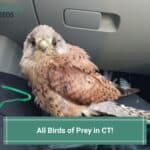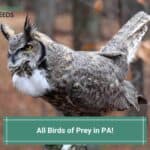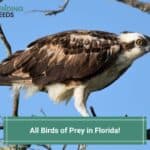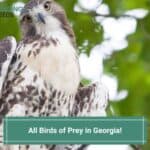
Are you someone who’s always on the lookout for raptors but has trouble identifying them? This guide shall help you identify birds of prey in Boise, Idaho!
The city is filled with natural resources and is one of the best places you can find various species of birds of prey.
A huge population of different raptors can be spotted around the multiple parks and greenspaces in Idaho’s capital, Boise.
Be it the colorful American Kestrels or the ferocious-looking hawks, you can identify any bird of prey after reading this guide.
Let’s begin, shall we?
Before you scroll further down this guide, check out these other bird-related articles: Best Bird Rescues in Maine and Best Bird Rescues in New York.
Table of Contents
1. Sharp-Shinned Hawk
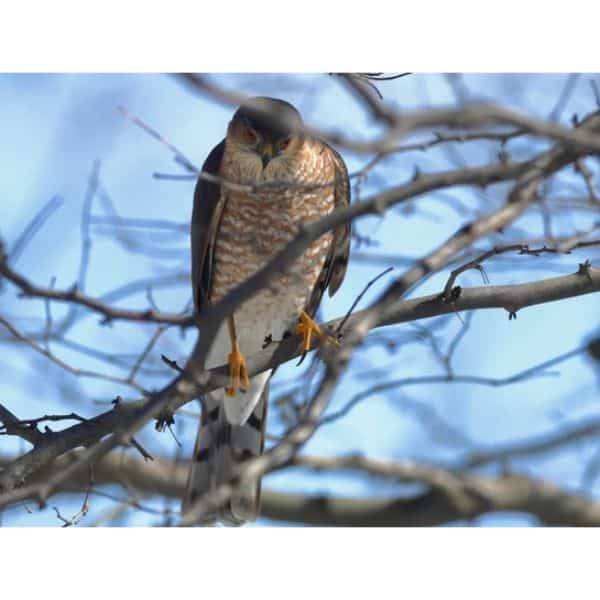
Sharp-shinned Hawk Characteristics:
- Scientific Name: Accipiter striatus
- Length: 9.1 to 11.8 in (23 to 30 cm)
- Weight: 2.9–4.1 oz (82–115 g)
- Wingspan: 17 to 23 in (42 to 58 cm)
- Life Span: Around 5 years
- Conservation: Least concern
Being extremely acrobatic and agile, Sharp-shinned Hawks are one of the smallest birds of prey that can be spotted throughout the year in Boise, Idaho.
Identification is fairly easy since these hawks have short and broad wings with a medium length tail with blackish-gray bands.
Their legs are pretty long and slender and yellow.
The upper feathers of these hawks are blue-gray, whereas the underparts are white with rufous bars.
The distinctive features include orange stripes on the chest and rufous cheeks. Females are typically 30% longer and 50% heavier than males.
The Sharp-shinned Hawks prefer to live among trees and thus inhabit forests and woodlands.
Thus their ability to fly through tight spaces and a stealthy way of hunting is an adaptation to their habitat.
They may also be found in your backyards near feeders looking to prey on sparrows and songbirds.
Sharp-shinned Hawks hunt their prey from cover in dense vegetation and mainly feed on small birds such as sparrows, wood warblers, finches, wrens, and thrushes.
Females may hunt down larger birds, such as American robins and flickers.
These small raptors build nests in large coniferous or deciduous trees.
The typical clutch size is 4 to 5 eggs, and the incubation period is about 30 days. They make high-pitched “kik-kik-kik” sounds.
2. Ferruginous Hawk

Ferruginous Hawk Characteristics:
- Scientific Name: Buteo regalis
- Length: 20 to 28 in (51 to 71 cm)
- Weight: 32.0 to 80.0 oz
- Wingspan: 48 to 62 in (122 to 158 cm)
- Life Span: 16-20 years
- Conservation: Least concern
Ferruginous Hawks are one of the largest birds of prey in Boise, Idaho. Ferruginous Hawks can be light and dark morphs.
Light morphs have a rusty brown plumage on the upper side with pale underbelly and heads.
If you can spot a light morph, Ferruginous Hawk, you’ll see rust-colored markings on the underwings.
In comparison, dark morph Ferruginous Hawks birds have dark brown feathers all over their body with light-colored wing tips.
The grayish-white tails are common in both morphs.
Ferruginous Hawks prefer open country grounds. These raptors avoid forests and elevated cliff sides but may inhabit prairies, foothills, and middle elevated plateaus.
Ferruginous Hawks are known to deploy various hunting techniques. Their diet is limited and based on small mammals.
They eat rabbits, hares, gophers, and ground squirrels. They may also eat insects, reptiles, and birds.
3. Red-Shouldered Hawk
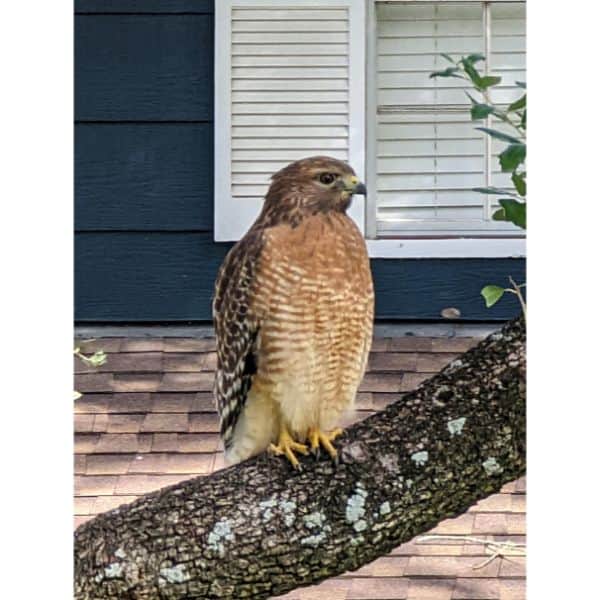
Red-shouldered Hawk Characteristics:
- Scientific Name: Buteo lineatus
- Length: 16.9-24.0 in (43-61 cm)
- Weight: 17.1-27.3 oz (486-774 g)
- Wingspan: 37.0-43.7 in (94-111 cm)
- Life Span: 10-20 years
- Conservation: Least concern
Red-shouldered Hawks are medium-sized hawks found primarily during springs and summers in Boise, Idaho. They are highly territorial and monogamous.
Red-shouldered hawks are with reddish feathers on their breast. The feathers on their undersides are white with red patterns.
The Red-shouldered hawks are found in woodlands near water bodies. They are primarily forest dwellers and reside on tree tops.
These smallish hawks hunt and eat small mammals, rodents, amphibians, and reptiles. Breeding maturity is usually attained at 1 or 2 years of age.
They lay 2-5 blotchy-marked eggs, often brown to lavender in color per mating cycle.
The main threat to the populations of Red-shouldered Hawks has been incessant deforestation. However, they remain of least concern for conservation status.
4. Swainson’s Hawk
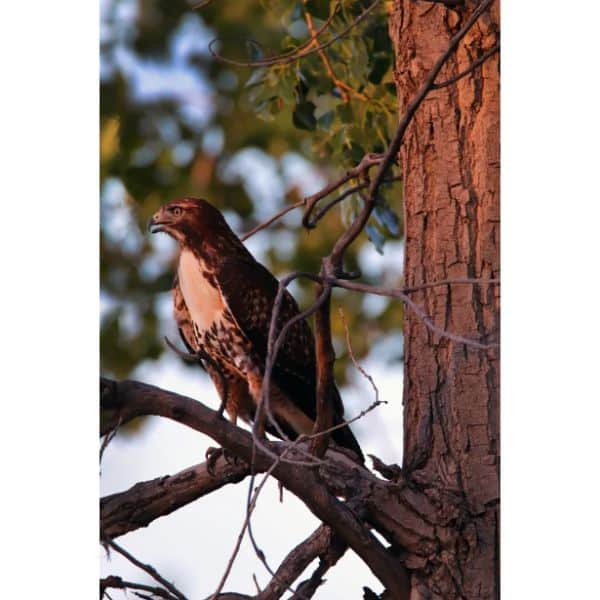
Swainson’s Hawk Characteristics:
- Scientific Name: Buteo swainsoni
- Length: 17–22 in (43–56 cm)
- Weight: 24.4-48.2 oz (693-1367 g)
- Wingspan: 46–54 in (117–137 cm)
- Life Span: 16-19 years
- Conservation: Least concern
Sawinson’s Hawks can be primarily spotted during summers in Boise, Idaho, which remains their preferred site for raising their young.
These hawks show sexual dimorphism, with females being distinctly larger than males.
Swainson’s Hawks have two color forms: light and dark. You will see light morphs in Boise more than dark morphs.
Light-colored Swainson’s Hawks have brownish-black feathers with white patterns on their upper body, while their underbelly is white with a red patch at the breast.
They have a grey-brown tail that fans out in flight.
In contrast, the darker-colored Swainson’s Hawks are all brownish-black with red streaks on their wings and their chest.
Dark morphs also have a patch of white under their tail.
Swainson’s Hawks live in open areas, like grasslands and prairies.
Their diet includes insects, rodents, reptiles, and small mammals. They may also hunt down other birds of prey.
5. Broad-Winged Hawk
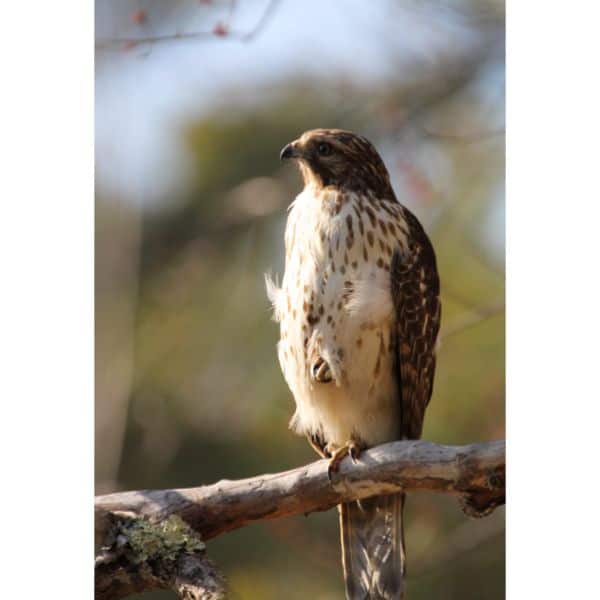
Broad-winged Hawk Characteristics:
- Scientific Name: Buteo platypterus
- Length: 13 to 17 in (32 to 44 cm)
- Weight: 9.3 to 19.8 oz (265 to 560 g)
- Wingspan: 29 to 39 in (74 to 100 cm)
- Life Span: 12-14 years
- Conservation: Least concern
Broad-winged Hawks are medium-sized hawks that exist in two types of coloration.
These are secretive hawks about the size of American Crows.
The two types of coloration include a dark morph with fewer white areas and a pale light morph.
An adult’s body is dark brown with a white belly and chest having horizontal bars.
They have short, broad wings that are tapered and pointed at the end. The tail is dark gray black with white lines.
Dark morph hawks are much rarer and dark brown on the upper and underparts.
These hawks inhabit deciduous forests, woodlands, meadows, and mixed forests.
These birds of prey try to stay away from human settlements and interactions and soar, using thermals.
Broad-winged Hawks are carnivorous and eat a variety of animals.
They usually feed on mice, chipmunks, voles, shrews, rabbits, and mice. They also hunt down frogs, snakes, lizards, grasshoppers, and other insects.
They attain sexual maturity at two years of age. Clutch size comprises 1 to 4 eggs incubated for 28 days or longer. They make high-pitched whistles like “kee-aah” calls.
6. Bald Eagle
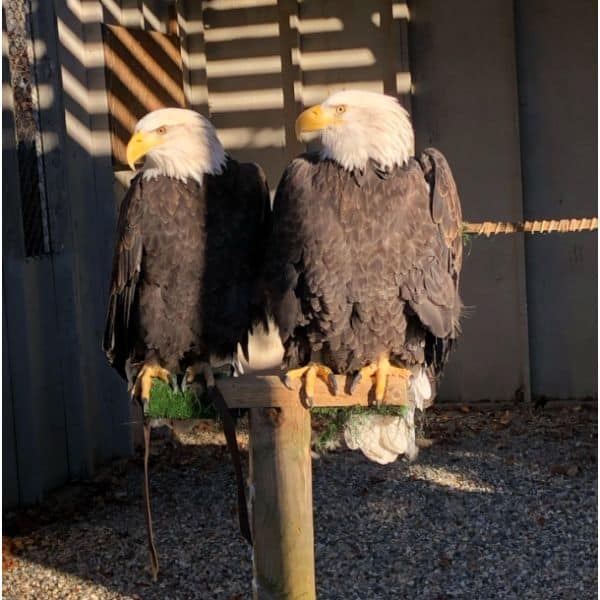
Bald Eagle Characteristics:
- Scientific Name: Haliaeetus leucocephalus
- Length: 34 – 43 in (86 – 109 cm)
- Weight: 168 oz (4761 g)
- Wingspan: 72 – 96 in (183 – 244 cm)
- Life Span: 20-30 years
- Conservation: Least concern
If you are looking for a feisty bird of prey that is classy and stylish, then Bald Eagle is your best contender.
Bald Eagles are one of the most recognizable raptors around Boise, Idaho.
Bald Eagles are not bald but white-headed. The head, contrasting with the chocolate brown feathery body and yellow legs with viciously huge talons, gives off a bald look.
They show sexual dimorphism, with the females being 25% larger. The plumage of the juvenile Bald Eagles is a dark brown carpeted with white streaking.
Bald Eagles are almost invariably found near water bodies. Nesting takes place in tall coniferous or hardwood trees.
Bald Eagles are known to build quite large nests. They are also sensitive to human interactions.
They are opportunistic feeders preying mostly on fish.
Also, Bald Eagles are notorious for being snatchers or harassers, obtaining their food via a method known as kleptoparasitism, by which they harass small raptors like Ospreys and steal away their prey.
Sexual maturity is attained until the fifth year. Females lay up to 3 years per mating cycle. To the surprise of many, these birds produce a rather squeaky, whistle-like sound.
7. Golden Eagle
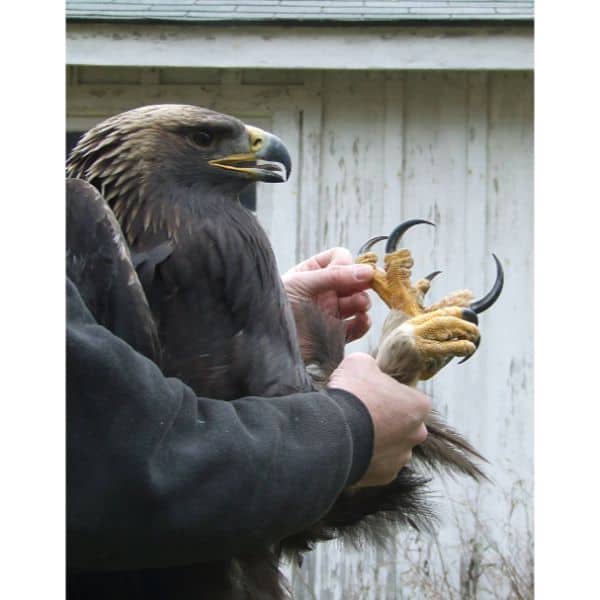
Golden Eagle Characteristics:
- Scientific Name: Aquila chrysaetos
- Length: 26-40 in (66-100 cm)
- Weight: 104-256 oz (3000-7000 g)
- Wingspan: 71-91 in (180 -230 cm)
- Life Span: Up to 30 years
- Conservation: Least concern
Golden Eagles are known to be quite brave and bold raptors and are year-round residents of Boise, Idaho. These are the most widely distributed eagles around the world.
Golden Eagles are fairly large birds of prey. The plumage is similar in both sexes and is dark brown. The inner wing and tail are gray.
The bird gets its name from the pale and golden color on the back of its neck.
The bill is dark at its tip, being yellow proximally. The feet are also yellow with sharp, huge, and curved talons for catching prey.
Golden Eagles tend to be quite adaptable raptors but prefer open areas for hunting purposes.
They inhabit mountainous areas beside vegetation and avoid dense forests and urban/suburban areas.
Golden Eagles tend to be more diverse in their diet than their relative, the Bald Eagles.
Golden Eagles are known to hunt fairly large animals and primarily feed on rabbits, hares, ground squirrels, prairie dogs, marmots, coyotes, small deers, and reptiles.
Golden Eagles are famous falconry birds and usually mate for life. Females lay 1 to 3 eggs, which are incubated for about 45 days.
8. Great Horned Owl
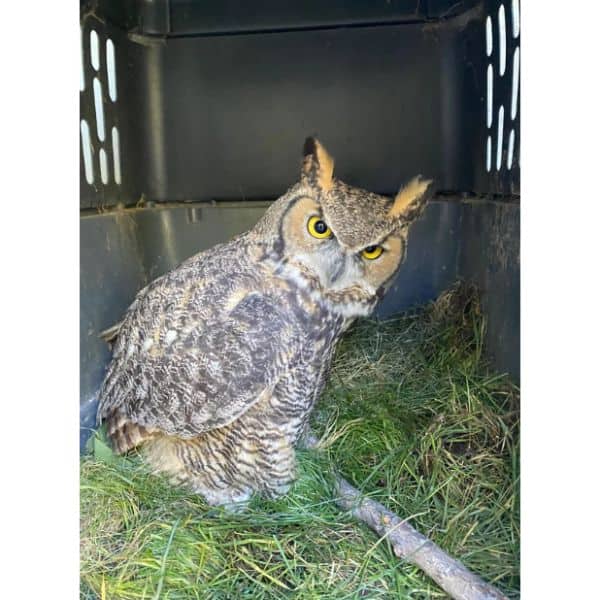
Great Horned Owl Characteristics:
- Scientific Name: Bubo virginianus
- Length: 18.1 – 24.8 in (46 – 63 cm)
- Weight: 32.1 – 88.2 oz (910 – 2500 g)
- Wingspan: 39.8 – 57.1 in (101 – 145 cm)
- Life Span: 20 – 30 years
- Conservation: Least concern
Great-Horned Owls can be spotted almost anywhere in Boise, Idaho, owing to their remarkable adaptability. These owls are large and fierce-looking.
The name of this raptor is derived from the two tufts of feathers that sprout from its head; these are visible even when the owl is in a sedentary position.
The plumage of the Great Horned Owl is brownish-blackish, aiding the bird in successful camouflage. The feathers on their belly are white with brown barring.
Moreover, the wings of this great owl are brown with complex patterns in a darker brown.
Great Horned Owls are highly adaptive birds, and they can live in any biome if food is available nearby. These owls are human-sensitive and avoid human settlements.
The Great Horned Owl commonly feeds on rodents, insects, reptiles, and small mammals.
They are opportunistic hunters, i.e., they eat whatever they can find, even carrion and other raptors!
9. Barred Owl

Barred Owl Characteristics:
- Scientific Name: Strix varia
- Length: 16 to 25 in (40 to 63 cm)
- Weight: 16.5 to 28.6 oz (468 to 812 g)
- Wingspan: 38 to 49 in (96 to 125 cm)
- Life Span: 10-20 years
- Conservation: Least concern
Also known as “striped owl,” “hoot owl,” or “eight-hooter owl,” the Barred Owl is one of the largest birds of prey in Boise, Idaho.
Their plumage is brown to gray with dark striping on the underbellies. The head is large and devoid of ear tufts.
The facial disks of these owls are pale grayish-brown with subtle dark concentric lines.
The brown color extends from the head to the back, and Barred Owls are covered in white bars on the mantle and the back.
Barred Owls normally inhabit old deciduous and mixed forests and occasionally coniferous forests.
They can also be spotted near swamp areas adjacent to wetlands and farmlands.
Barred Owls are opportunistic feeders and will eat anything that is meat.
They mostly feed on small animals and rodents such as rabbits, hares, and mice. They may occasionally eat fish, insects as well as reptiles.
Females lay 2 to 3 eggs, which are incubated for about 28 days. These owls make the famous hootcalls that are often featured on television.
10. Snowy Owl

Snowy Owl Characteristics:
- Scientific Name: Bubo scandiacus
- Length: 20.5-27.9 in (53 to 70.8 cm)
- Weight: 56.4-104.1 oz (1599 -2951.1 g)
- Wingspan: 49.6-57.1 in (125.9 – 145 cm)
- Life Span: 10-20 years
- Conservation: Least concern
One of the most fascinating and distinctive-looking birds, the Snowy Owl, can be spotted in Idaho during the winter.
Snowy Owl is the only species of owl with white plumage. Males are white overall, whereas females tend to have dark brown flecks.
The head is small, the facial disks are shallow, and they generally lack ear tufts.
Snowy Owls have bright yellow eyes. The toes of these owls are thickly feathered and white, whereas the claws are black.
Snowy Owls are nomadic birds. They typically prefer open and grassy areas. Their breeding ground is most often covered with mosses, lichens, and rocks.
These owls also prefer elevated sites such as hummocks, ridges, rocky outcrops, and knolls.
Unlike other owls, the Snowy Owl is pretty active during the daytime. They are primarily the hunters of small mammals, especially lemmings.
They also eat rodents, including mice and voles. Snowy Owls have been found to also feed on carrion.
Females lay 7 to 9 eggs with incubation periods ranging between 27 to 38 days.
11. Western Screech Owl
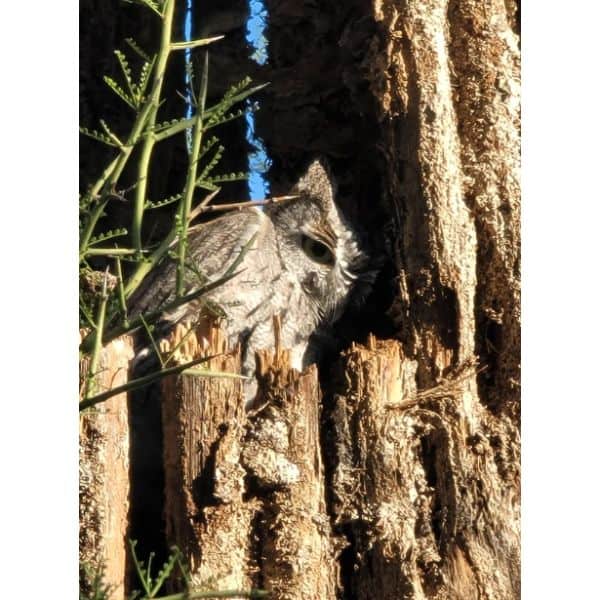
Western Screech Owl Characteristics:
- Scientific Name: Megascops kennicottii
- Length: 8.7 in (22 cm)
- Weight: 3.1 to 7.8 oz (88 to 220 g)
- Wingspan: 22 in (55 cm)
- Life Span: 8-13 years
- Conservation: Least concern
Western Screech Owls are small birds of prey that can be spotted quite easily around Boise, Idaho, owing to these birds’ fondness for greenspaces and parks.
Western Screech Owls have multiple morphs depending on regions. The plumage is brown or dark gray with multiple streaks on the undersides.
This color specifically helps them with camouflage. They are Whiskered Screech Owls with round heads and ear tufts.
Their eyes and beaks are yellow. Western Screech Owls can be mistaken for Eastern Screech Owls, but they have larger feet and more streaks.
Western Screech Owls inhabit temperate forests, shrublands, deserts, agricultural fields, as suburban gardens.
They usually breed in open woods or at forest edges. Nesting occurs in tree cavities and cliff edges commonly.
Western Screech Owls usually feed on small mammals such as rats, mice, bats, flying squirrels, birds, and insects such as cardinals and sparrows.
They also hunt down reptiles and amphibians.
Western Screech Owls produce a clutch of 2 to 7 eggs. They produce a rather pleasant and quiet “hoo-hoo” or “cro-o-o” sound.
12. American Barn Owl

American Barn Owl Characteristics:
- Scientific Name: Tyto furcata
- Length: 12.6-15.8 in (32–40.1 cm)
- Weight: 14.1-24.7 oz (399 to 700 g)
- Wingspan: 39.4-49.2 in (100–124.9 cm)
- Life Span: 2 to 4 years
- Conservation: Least concern
American Barn Owls are the last on our list of birds of prey in Boise, Idaho. They are year-round residents of Boise, Idaho, due to their global presence.
These are quite birds of prey that have been seen quite often around abandoned barns and hence the name.
These are medium-sized birds with pale plumage. The wings are long and pale-grayish on the upper side.
The distinctive features of the American Barn Owl are the heart-shaped facial disk and dark black eyes. The ridges above the beak give it a nose appearance.
American Barn Owls are open country birds that prefer secluded areas. They can be found in woodlands and farmland, especially abandoned barns.
They observe their prey from an elevated point and attack abruptly.
The diet commonly consists of bats, lizards, amphibians, reptiles, earthworms, shrews, and voles. They may also hunt baby rabbits and rats.
The clutch size averages five eggs that are chalky white and elliptical. The incubation period is around 30 days.
Frequently Asked Questions
Are there eagles in Boise?
Yes there are! Many say they can see eagles in Barber Dam.
Do golden eagles live in Idaho?
Golden eagles live in parts of Idaho.
What state do the most eagles live?
Most eagles live in Alaska.
All Birds of Prey in Boise, Idaho
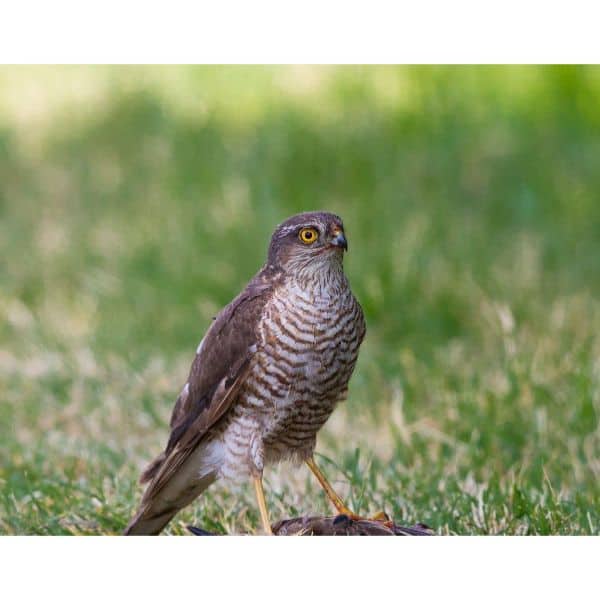
We have seen how one could find almost any type of bird of prey in Boise, Idaho.
For someone who is an avid bird watcher or even a simple tourist, the huge variety of raptors that can be spotted here can be truly soul-refreshing and a treat for the eyes.
Based on the knowledge of prey, nesting sites, and plumage, one can easily identify any bird of prey.
These raptors add to the area’s beauty and are an essential component of the natural ecosystem.
We hope the next time you are out on bird sighting, this guide will surely help you in spotting a bird or two. Happy bird watching!
If you find this guide, “All Birds of Prey in Boise, Idaho,” informative and helpful, you can check out these other bird-related articles from our team:
You can learn more about birds by watching “How to Choose Your First Bird of Prey” down below:

